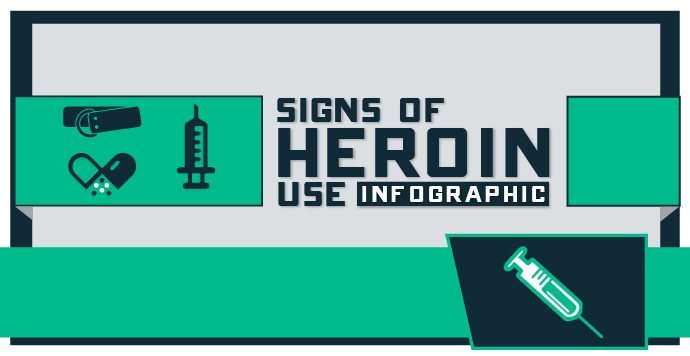Signs of Heroin Use Infographic

Heroin is one of the most dangerous drugs in the world and it causes a wide range of physical, emotional, and psychological problems. These problems can change a person’s appearance, alter their physical health, and change their personality.
Spotting these problems in a loved one requires understanding and spotting the various symptoms that they cause. Doing so is crucial to helping diagnose your loved ones addiction and helping them find a way to beat it.
Unfortunately, these symptoms often vary in severity, meaning they can be hard to spot early on. At first, a person may show little to no signs of heroin abuse. However, later on your loved one will seem to have disappeared, only to be replaced by someone you don’t recognize and can’t understand.
Those changes generate symptoms that fall into a wide range of categories, including physical, behavioral, and psychological. Heroin use also causes the presence of certain types of suspicious paraphernalia. This infographic will help you understand how to spot these symptoms in your loved ones.
With its help, you’ll understand their heroin addiction and be more capable of helping them find a way to recover a sober lifestyle. For example, you’ll learn how to spot:
- Physical symptoms (such as constricted pupils and labored breathing)
- Behavioral problems (such as drowsiness, delirium, or poor behavior)
- Psychological concerns (such as paranoia and unexplained disappearances)
- Drug paraphernalia (including burnt spoons, needles, belts, razor blades, tubing, or the scent of burning vinegar)
Once you’ve spotted these symptoms, you need to help your loved one find a treatment method. The dangers of withdrawal often requires the use of transitional medications, such as methadone or suboxone, as well as behavioral management techniques and psychological counseling.
To learn more about how to spot signs of heroin use and how you can help your loved one recover from addiction, please read our more involved, informative, and intensive post on the subject. It can help you understand the problem and guide your loved one towards recovery in a constructive and healthy manner.
To read more about the signs of heroin use, click here
To download a PDF version of this infographic, click here

Introducing
virtual care
Get treatment when
and how you need it.


 Resources about addiction and recovery
Resources about addiction and recovery
